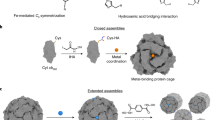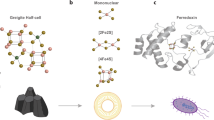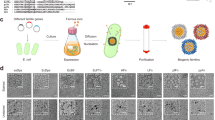Abstract
Hydrolytic polymerization of iron(III) occurs in many reactions in vivo, for example, the formation of bacterial magnetite in magnetotactic organisms1, biomineralization of iron2 and the synthesis of the metallic core of the iron-storage protein ferritin3. The ferritin core contains aggregates of up to 4,500 oxygen-bridged, octahedrally coordinated, high-spin iron(III) centres and is attached to the protein shell through carboxylate groups of amino-acid side chains. The X-ray and electron-diffraction patterns of this core resemble those of the mineral ferrihydrite4, a hydrated iron oxide formed in nature, inter alia, by iron-dependent bacteria. The preparation and structural characterization of such large poly-iron aggregates has been a challenge to inorganic chemists5,6. We have recently shown that tri- and tetranuclear iron(III) oxo complexes of the type thought3,7,8 to be important in ferritin-core formation can be prepared by reacting mononuclear [FeCl4]− and binuclear [Fe2OCl6]2−components in aprotic solvents (ref. 9 and S.M.G., W. H. Armstrong and S.J.L., in preparation). Here we report the discovery of a remarkable new molecule, [Fe1106(OH)6(02CPh)15], obtained by hydrolysis of the {Fe2O}4+ unit in the presence of limited amounts of water and carboxylate salts. The synthesis and properties of this soluble iron(III) oxo-hydroxo aggregate should help to elucidate the mechanism of formation of poly-iron centres.
This is a preview of subscription content, access via your institution
Access options
Subscribe to this journal
Receive 51 print issues and online access
$199.00 per year
only $3.90 per issue
Buy this article
- Purchase on Springer Link
- Instant access to full article PDF
Prices may be subject to local taxes which are calculated during checkout
Similar content being viewed by others
References
Mann, S., Frankel, R. B. & Blakemore, R. P. Nature 310, 405–407 (1984).
Lowenstam, H. A. Science 211, 1126–1130 (1981).
Ford, G. C. et al. Phil. Trans. R. Soc. B304, 551–565 (1984).
Chukrov, F. V., Zvyagin, B. B., Gorschkov, A. I., Yermilova, L. P. & Balashova, V. V. Int. geol. Rev. 16, 1131–1143 (1974).
Spiro, T. G. et al. J. Am. chem. Soc. 88, 2721–2726 (1966).
Wieghardt, K., Pohl, K., Jibril, I. & Huttner, G. Angew. Chem. int. Ed. Engl. 23, 77–78 (1984).
Theil, E. C. Adv. inorg. Biochem. 5, 1–38 (1983).
Chasteen, N. D., Antanaitis, B. C. & Aisen, P. J. biol. Chem. 260, 2926–2929 (1985).
Gorun, S. M. & Lippard, S. J. J. Am. chem. Soc. 107, 4568–4569 (1985).
Armstrong, W. H. & Lippard, S. J. Inorg. Chem. 24, 981–982 (1985).
Blaise, A., Chappert, J. & Girardet, J. C.r. hebd. Séanc. Acad. Sci., Paris 261, 2310–2313 (1965).
Webb, J. & Gray, H. B. Biochim. biophys. Acta 351, 224–229 (1974).
Sommer, B. A., Margerum, D. W., Renner, J., Saltman, P. & Spiro, T. G. Bioinorg. Chem. 2, 295–309 (1973).
Macara, I. G., Hay, T. G. & Harrison, P. M. Biochem. J. 126, 151–162 (1972).
Author information
Authors and Affiliations
Rights and permissions
About this article
Cite this article
Gorun, S., Lippard, S. A new synthetic approach to the ferritin core uncovers the soluble iron(III) oxo-hydroxo aggregate [Fe11O6(OH)6(O2CPh)15]. Nature 319, 666–668 (1986). https://doi.org/10.1038/319666a0
Received:
Accepted:
Issue Date:
DOI: https://doi.org/10.1038/319666a0
This article is cited by
-
‘Ionic crystals’ consisting of trinuclear macrocations and polyoxometalate anions exhibiting single crystal to single crystal transformation: breathing of crystals
Journal of Chemical Sciences (2017)
-
Selective formation of spinel iron oxide in thin films by complexing agent-assisted sol-gel processing
Journal of Sol-Gel Science and Technology (1997)
-
Control of structure and particle size of iron oxide on carrier oxide by the sol-gel method using organic polydentate ligands
Journal of Sol-Gel Science and Technology (1994)
Comments
By submitting a comment you agree to abide by our Terms and Community Guidelines. If you find something abusive or that does not comply with our terms or guidelines please flag it as inappropriate.



